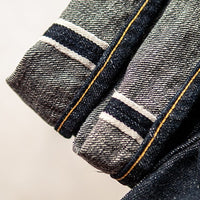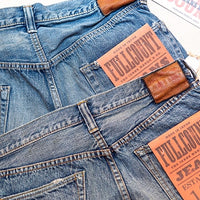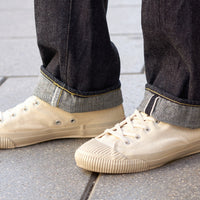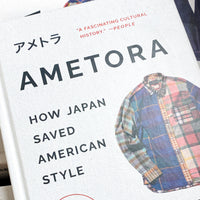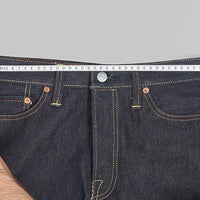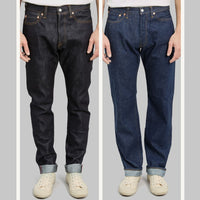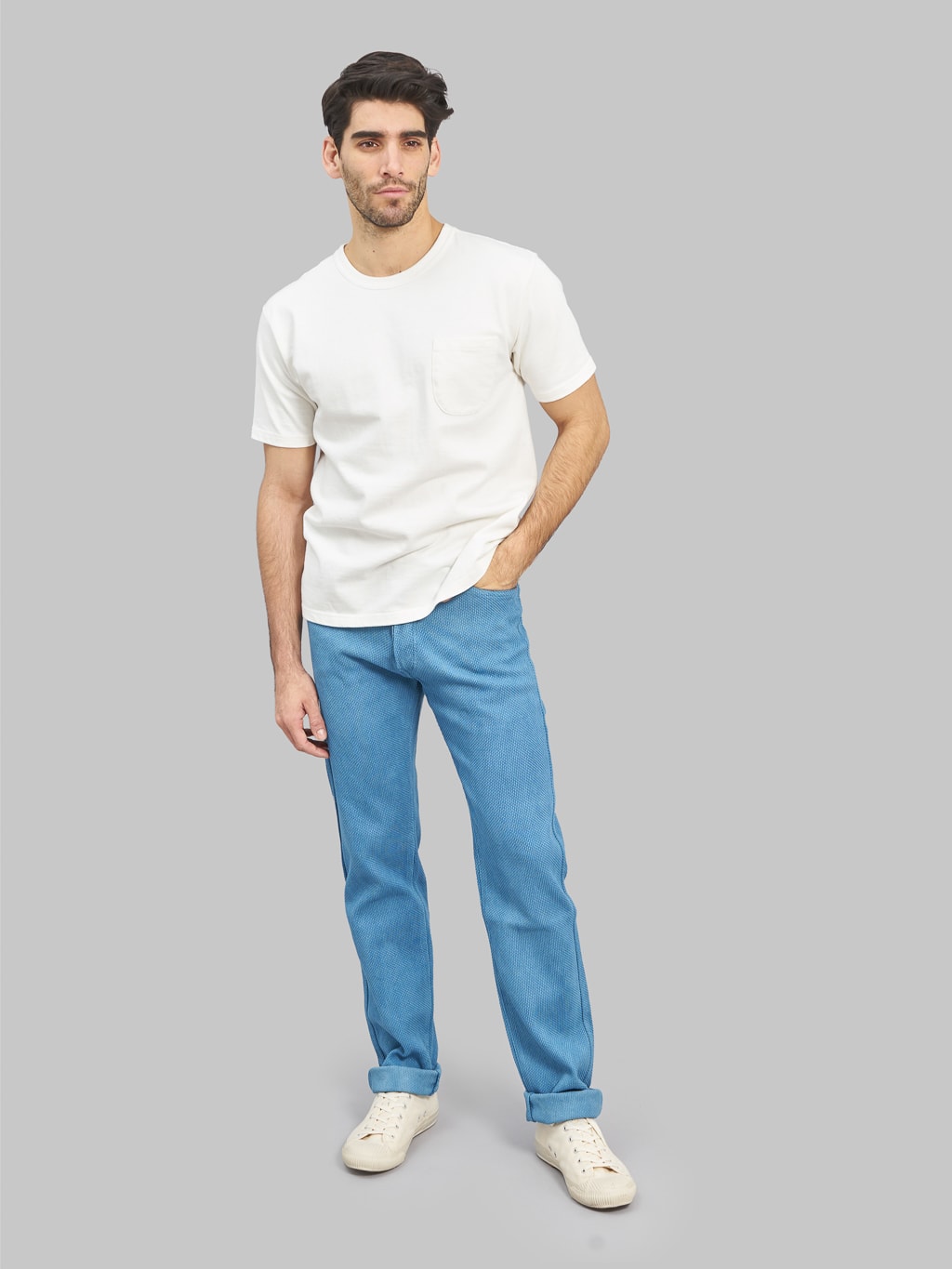
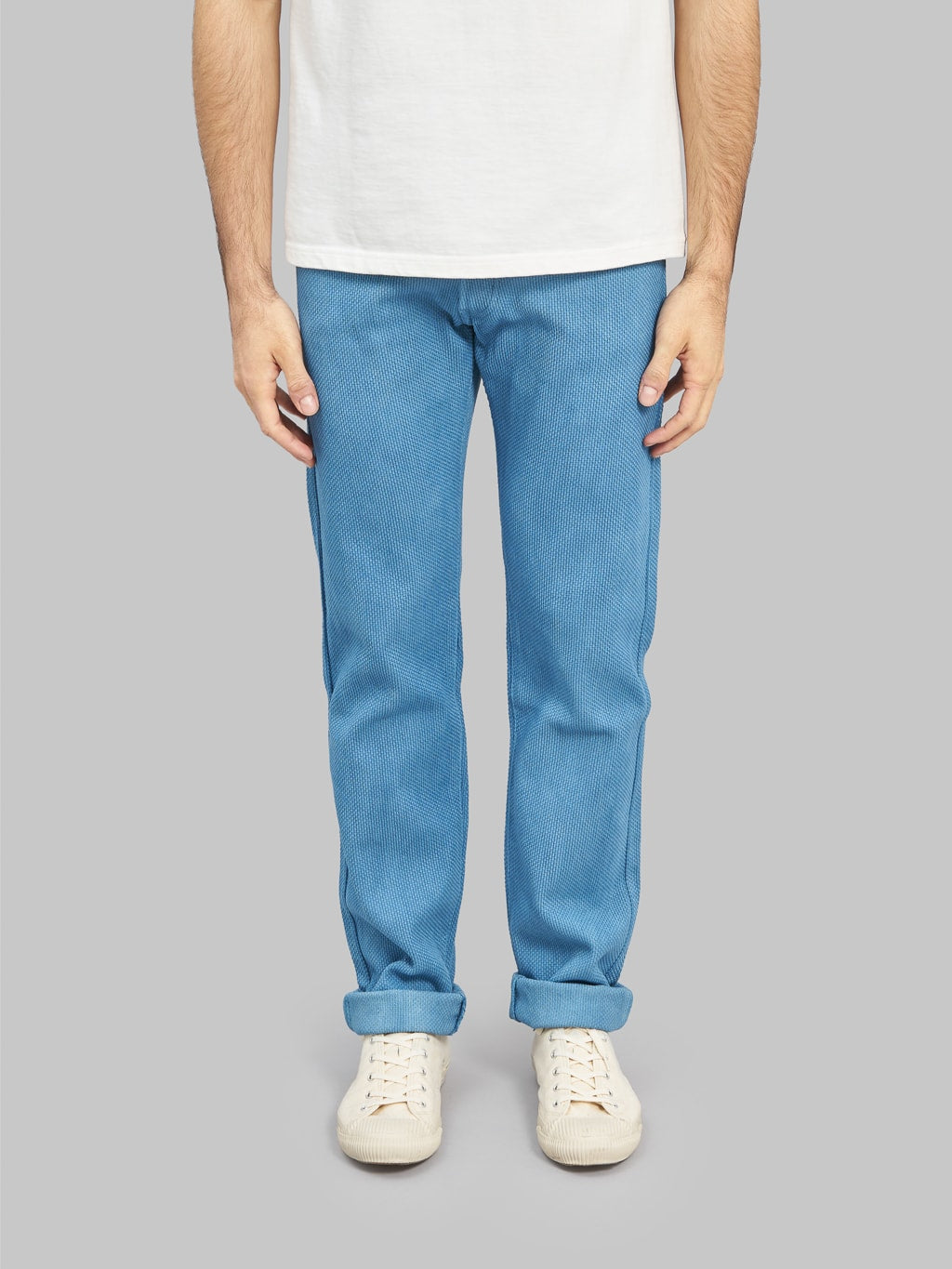



















Studio D'Artisan 1880 "AWA-AI" Natural Indigo Sashiko Regular Tapered Jeans
Studio D'Artisan unveils the "AWA-AI" capsule collection, featuring meticulously crafted sashiko jeans with Awa-ai indigo dye, showcasing centuries-old Japanese craftsmanship in limited quantities for a unique and timeless style.
| SIZE | 30 | 31 | 32 | 33 | 34 | 36 | 38 | 40 |
| Waist | 78 | 80 | 82 | 84 | 87 | 90 | 93 | 100 |
| Hip | 52.5 | 53 | 55 | 56 | 56.5 | 58.5 | 60 | 63 |
| Front Rise | 27.5 | 28 | 28.5 | 29 | 29.5 | 30 | 30.8 | 31.3 |
| Back Rise | 38.5 | 39 | 40 | 40.5 | 41 | 41.5 | 42 | 43 |
| Thigh | 30.5 | 31 | 31.5 | 32 | 32.5 | 33.3 | 34.5 | 36 |
| Knee | 21 | 21.5 | 22 | 22.5 | 23 | 23.5 | 24.5 | 25 |
| Leg Opening | 18 | 18.5 | 19 | 19.5 | 20 | 20.5 | 21.5 | 22.5 |
| Inseam | 86.5 | 86.5 | 86.5 | 86.5 | 86.5 | 87.5 | 87.5 | 87.5 |
You can have your jeans hemmed with our vintage Chainstitching Machine. The cost for this service is €10,00 and will be added to your cart. Please remember that hemmed jeans or pants are non-returnable, so make sure to carefully check the size chart.
• It will take 4-5 additional business days.
• Please follow our measuring guide to check your inseam.
We're thrilled to introduce the new "AWA-AI" capsule collection from Studio D'artisan. This capsule includes some of the most unique natural indigo hand dyed pieces we have ever seen. These exquisite sashiko jeans are meticulously crafted with Awa-ai, an indigo dyeing technique handed down through centuries. Produced in limited quantities, each pair is a testament to artisanal mastery, as skilled craftsmen hand-dye long staple cotton yarns to create a truly unique Sashiko texture. The straight-cut silhouette gracefully tapers from the knee down, ensuring a timeless and flattering fit.
Each unit undergoes a meticulous hand-dying process, making every pant a one-of-a-kind masterpiece. Influenced by the interplay of sunlight and humidity, some jeans emerge slightly darker, while others boast a lighter hue, imparting an individual charm to each garment.
Indigo is said to be the oldest dye used by humans worldwide. It was introduced to Japan around 1500 years ago. It was considered a noble color predominantly worn by courts and upper aristocrats during the Heian period. It was during the Edo period that indigo spread among the common people, and it is said that kimonos, work clothes, shop curtains, and even bedclothes were dyed in indigo. Being loved by the Japanese as an auspicious color, indigo was the symbolic color of Japan during the Meiji era, referred to as "Japan Blue" in other countries. Studio D'Artisan has created a new "JAPAN INDIGO" in which the beloved indigo dyeing and indigo Kasuri techniques, using Japanese methods, are incorporated into a modern style with the skills and knowledge of craftsmen.
Indigo dyeing in Tokushima is said to have been introduced to Japan around 900 AD by the lord of Awa, Hachisuka, who recognized that the climate along the Yoshino River was suitable for indigo cultivation. The technique used in indigo dyeing in Tokushima is called "fermentation," with Awa indigo as a raw material. Since it cannot be dyed to a dark shade all at once, the process of dyeing, squeezing, and drying is repeated many times. It is said that the authentic color achieved through the Awa Shoai dyeing technique (hank dyeing) is obtained after washing with water about 30 times, during which the uneven color is washed off until a deep shade is achieved. Also, the unique scent with an insect repellent effect contributes to the atmosphere with seasonal transitions, giving the wearer peace of mind. In 1968, the "Awa Shoai dyeing technique" was designated as an intangible cultural property of Tokushima, and it is still preserved today.
These jeans are expensive, but the Japanese method of creating indigo dye is labor-intensive and incredibly time-consuming. Leaves are carefully gathered from the indigo plant and placed under thick straw mats for months on end. To ensure the leaves ferment properly, very specific conditions must be consistently maintained. Workers must perform daily maintenance to ensure that the leaves have proper airflow and stay at a temperature around 60 degrees Fahrenheit.
From picking the leaves to completion, the entire fermentation process takes approximately one full year. Finally, after months of patience and dedicated work, the final result is something that resembles dirt, but with a pungent, vinegary aroma. This product, known as "sukumo," serves as the basis for indigo dye.
Just as the indigo dyers of hundreds of years ago, the "Awa Shoai" dyeing is a manual process, done on hands and knees while leaning over a large metal vat of inky blue indigo dye. The shade of blue after one dip will be very light, and the dipping process must be repeated multiple times to achieve darker colors.
Awa Shoai process:
- Grow Ai (藍 in Japanese, which is Natural indigo) leaves from March to July/August and cut the leaves in summer.
- The cut leaves are fermented for 100 days to make Natural indigo dye.
- Hank dye the yarns by very skilled craftsmen in Tokushima. Dyeing process: dip, squeeze, and wash the bunch of yarns – repeating this process about 12-14 times to achieve the dark color. Washing with water about 30 times.
These sashiko jeans feature a mid-high rise and are made with all the high-quality Studio D'Artisan features such as custom copper buttons, high-quality pocket bags, and a thick cowhide unwashed leather patch. Studio D'Artisan chose to stitch the leather patch after the temper treatment. This was a costly step because the jeans needed to return to the sewing workshop after the initial washing process. However, they did this to achieve the best look.
As many other SDA Jeans, they run slightly small. In general, we recommend choosing one size larger than your usual. However, as always, we recommend checking the size chart first to find your perfect size. It is unsanforized but one washed, so there will be no shrinkage.
Under the slogan of "Reconstruction of great old things", Studio D'Artisan is one of the iconic brands of Japanese denim. Founded by Shigeharu Tagaki and reproducing classics of French and American workwear since 1979, Studio D'Artisan takes pride in having been one of the Osaka 5.
Visit our LOOKBOOK and discover a great selection of heritage street-style outfits
Details
Shipping
Spain
FREE SHIPPING on orders over 100 EUR.
6 EUR shipping cost on orders under the value mentioned above.
European Union & The UK
FREE SHIPPING on orders over 150 EUR
14 EUR shipping cost on orders under the value mentioned above.
Rest of the World
FREE SHIPPING on orders over 250 EUR.
25 EUR shipping cost on orders under the value mentioned above.
Returns
If for some reason you are not happy with your purchase you can return it to us within 14 days for a free size exchange or refund.
For more info please visit our returns & exchange page.
Please note that items in the SALE category are considered FINAL SALE, with no returns or exchanges accepted.
Reviews

| SIZE | 30 | 31 | 32 | 33 | 34 | 36 | 38 | 40 |
| Waist | 78 | 80 | 82 | 84 | 87 | 90 | 93 | 100 |
| Hip | 52.5 | 53 | 55 | 56 | 56.5 | 58.5 | 60 | 63 |
| Front Rise | 27.5 | 28 | 28.5 | 29 | 29.5 | 30 | 30.8 | 31.3 |
| Back Rise | 38.5 | 39 | 40 | 40.5 | 41 | 41.5 | 42 | 43 |
| Thigh | 30.5 | 31 | 31.5 | 32 | 32.5 | 33.3 | 34.5 | 36 |
| Knee | 21 | 21.5 | 22 | 22.5 | 23 | 23.5 | 24.5 | 25 |
| Leg Opening | 18 | 18.5 | 19 | 19.5 | 20 | 20.5 | 21.5 | 22.5 |
| Inseam | 86.5 | 86.5 | 86.5 | 86.5 | 86.5 | 87.5 | 87.5 | 87.5 |


